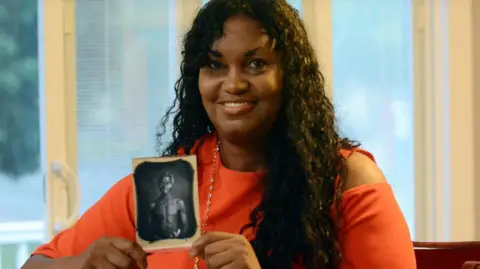BBC News
 Reuters
ReutersHarvard University agreed to teach a set of historical photographs believed to be among the earliest presentation of enslaved people in the United States.
The agreement ends the long legal battle between the Institution and Tamara Lanier, the author of Connecticuta who claims that the descendant of two people are shown in the photographs.
Pictures, which were taken in 1850. years, are transferred to the International African American Museum in South Carolina, where people are presented in photographs enslaved.
Harvard said he always hoped the photos would be given to another museum. Ms. Lanier said that the “ecstatic” result was the result.
Pictures are Dagerotypes, a very early form of modern photos and took 15 years ago 13. Amendments to the American Constitution revoked slavery.
The photos were re-discovered in the warehouse at Harvard Peaboda Museu Archeology and ethnology in 1976. years.
15 Pictures There are people who identified the Museum of Peaboda as Alfred, Delia, Drana, Facena, Jack, Jem and Rent. According to MS LANIER, the settlement would mean the transfer of all images not only those about restoration and delivery.
The photos were ordered by Professor Harvard and Zoologist Louis Agassiz as part of a discredited research to prove the superiority of white people. He respected polygenism, is now a separate belief that human races developed separately.
The case was formed part of a public debate on how American universities should respond to their historical ties to slavery. In 2016, the Harvard Legal School agreed to change the shield based on the Robonic Rechonik from the 18th century.
Harvard did not comment on the details, but the University spokesman said that “long eager to appoint dagroots with other museums or other public institutions to put them in an appropriate context and increases access to all Americans.”
The spokesman added that “the claim of Mrs. Lanier” has created a complex situation at Dagerotypes, especially because Harvard failed to confirm that MS Lanier is connected to individuals in Dagerootypes. “
 Getti images
Getti imagesMS Lanier Sad Harvard in 2019 yearsBy claiming that the pictures were taken without consent and accusing the university in them through major licensing fees.
In 2022. year, the Supreme Court for Massachusetts confirmed the earlier verdict that rejected Ms. Lanier’s claim. However, it was allowed to demand the damage for emotional distress. The rule Harvard had “complicity” in “terrible actions” around the creation of images.
“Harvard’s current liabilities cannot be divorced from its previous abuses,” he added.
Ms. Lanier told the BBC, she was “ecstatic” about the settlement. “I always knew I could never care for me for daggerotypes at the level that would require,” she said.
“There are so many connections that bind and share, and other enslaved to that particular part of South Carolina that would bring them back to be like a home home ceremony.”
Museum of South Carolina helped Ms. Lanier with his genealogical claims, but was not involved in the legal battle. His president said they intend to hold and show images “in context with truth and empathy.”
“These are not gentle images and the story behind them as they came to hear her even harder,” Tonia Matthews said.
“So to be in a space that has already created space for talks about inhumanity of slavery and enslavement and how many implications echo and today it worked today and that is our mission today.”






